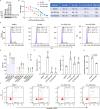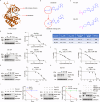Linker-free PROTACs efficiently induce the degradation of oncoproteins
- PMID: 40410168
- PMCID: PMC12102262
- DOI: 10.1038/s41467-025-60107-7
Linker-free PROTACs efficiently induce the degradation of oncoproteins
Abstract
Proteolysis-targeting chimeras (PROTACs) present a potentially effective strategy against various diseases via selective proteolysis. How to increase the efficacy of PROTACs remains challenging. Here, we explore the necessity of the linker, which has been deemed as an integral part of heterobifunctional PROTACs. Adopting single amino acid-based degradation signals, we find that the linker is not a required feature of the PROTACs. Notably, the linker-free PROTAC, Pro-BA, exhibits superior efficacy over its linker-bearing counterparts in degrading EML4-ALK and inhibiting lung cancer cell growth, as Pro-BA induces a stronger interaction between the target and the E3 ubiquitin ligase. Pro-BA is a water-soluble, orally administered degrader that significantly inhibits the tumor growth in a xenograft mouse model. The broad applicability of this linker-free PROTAC strategy is further validated through the development of BCR-ABL degrader. Our study introduces a design paradigm for PROTACs, potentially facilitating the advancement of more efficient therapeutic degraders.
© 2025. The Author(s).
Conflict of interest statement
Competing interests: H.R., J.Z., and L.F. are co-inventors on a patent application related to the PROTACs described in this paper (applicant: Southern University of Science and Technology; Shenzhen Institute of Advanced Technology, Chinese Academy of Sciences; inventors: H.R., J.Z., and L.F.; application number: PCT/CN2024/129836). The other authors declare no competing interests.
Figures







References
-
- Sathe, G. & Sapkota, G. P. Proteomic approaches advancing targeted protein degradation. Trends Pharmacol. Sci.44, 786–801 (2023). - PubMed
MeSH terms
Substances
Grants and funding
- 82170159/National Natural Science Foundation of China (National Science Foundation of China)
- 82473177/National Natural Science Foundation of China (National Science Foundation of China)
- 2025A1515011516/Natural Science Foundation of Guangdong Province (Guangdong Natural Science Foundation)
- 2023A1515011765/Natural Science Foundation of Guangdong Province (Guangdong Natural Science Foundation)
LinkOut - more resources
Full Text Sources
Medical
Miscellaneous

